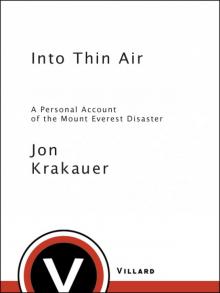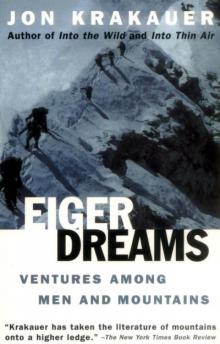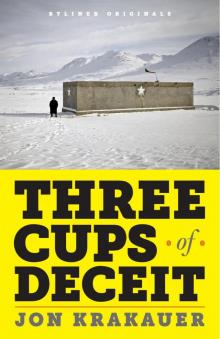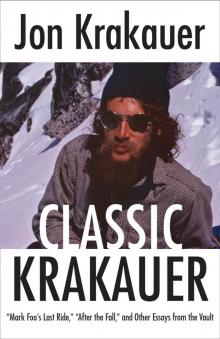- Home
- Jon Krakauer
Classic Krakauer
Classic Krakauer Read online
Jon Krakauer
Classic Krakauer
“Mark Foo’s Last Ride,” “After the Fall,” and Other Essays from the Vault
Jon Krakauer is the author of Eiger Dreams, Into the Wild, Into Thin Air, Under the Banner of Heaven, Where Men Win Glory, Three Cups of Deceit, and Missoula. He is also the editor of the Modern Library Exploration series.
www.jonkrakauer.com
ALSO BY JON KRAKAUER
Eiger Dreams
Iceland
Into the Wild
Into Thin Air
Under the Banner of Heaven
Where Men Win Glory
Three Cups of Deceit
Missoula
Classic Krakauer
“Mark Foo’s Last Ride,” “After the Fall,” and Other Essays from the Vault
Jon Krakauer
Anchor Books
A Division of Penguin Random House LLC
New York
Compilation copyright © 2018 by Jonathan R. Krakauer
All rights reserved. Published in the United States by Anchor Books, a division of Penguin Random House LLC, New York, and distributed in Canada by Random House of Canada, a division of Penguin Random House Canada Limited, Toronto.
Anchor Books and colophon are registered trademarks of Penguin Random House LLC.
The pieces first appeared in the following publications:
Medium: “Embrace the Misery” (July 29, 2014)
The New Yorker: “Death and Anger on Everest” (April 21, 2014)
Outside: “After the Fall” (June 1990), “Fred Beckey Is Still on the Loose” (July 1992), “Loving Them to Death” (October 1995), “Mark Foo’s Last Ride” (May 1995)
Smithsonian: “Gates of the Arctic” (June 1995), “Living Under the Volcano” (July 1996)
Smithsonian Air & Space: “Descent to Mars” (November 1995)
Anchor Books eBook ISBN 9780525562733
Cover photograph © Pam Brown
www.anchorbooks.com
v5.2
a
Contents
Cover
About the Author
Also by Jon Krakauer
Title Page
Copyright
Introduction
Mark Foo’s Last Ride
Living Under the Volcano
Death and Anger on Everest
Descent to Mars
After the Fall
Gates of the Arctic
Loving Them to Death
Fred Beckey Is Still on the Loose
Embrace the Misery
Introduction
I embarked on a literary career in the early 1980s by writing freelance magazine articles for Outside, Rolling Stone, Smithsonian, and a motley of lesser-known publications. To make rent, I had to hustle thirty or forty assignments per year, and most of what I wrote was garbage. But I managed to scrape together a meager living, and learned my craft in the bargain. In 1990, a small independent publisher collected a dozen short pieces I’d written about climbing and published them as a book called Eiger Dreams: Ventures Among Men and Mountains, for which they paid me an advance of $2,000. I was ecstatic.
This princely sum wasn’t enough to keep the creditors at bay, however, so I continued to crank out magazine pieces at a frenetic pace, one of which I expanded into a second book, Into the Wild, published in January 1996. After my third book, Into Thin Air, was released fifteen months later, I had the financial means to cut back drastically on magazine work and pursue book-length projects instead. It was liberating to be able to focus on a single undertaking for five or six years, instead of juggling multiple assignments that had to be completed in a matter of months, if not weeks, to ward off financial disaster.
Most of the short pieces I wrote during the years between Eiger Dreams and Into Thin Air vanished into the crevices of time and have been forgotten. But Anchor Books has retrieved seven articles from this period, plus two more recent essays, and rescued them from oblivion with this new collection, Classic Krakauer: “Mark Foo’s Last Ride,” “After the Fall,” and Other Essays from the Vault. Thanks for giving it a look.
Mark Foo’s Last Ride
Twenty-two miles down Highway 1 from San Francisco, a craggy fist of land called Pillar Point thrusts emphatically into the cold Pacific. Friday, December 23, 1994, dawned fair over this stretch of coast. Mountainous waves crashed against the headlands, spraying up billows of mist that unfurled languidly across the beaches. Beyond the end of the point, some fifteen surfers bobbed in the muted winter sunlight, scanning the horizon for approaching swells.
It was not uncommon to see surfers off the point—a spot they called Mavericks—dressed in heavy, hooded wetsuits and sitting astride oversize boards. But the hovering helicopter, the three boats of photographers just outside the surf line, and the throng of spectators lining the cliffs suggested this was no ordinary surf session.
For more than a week, the largest, most perfectly shaped waves in a decade had been thundering over the reef at the end of Pillar Point. Word traveled quickly over the international surfers’ grapevine: Mavericks, which had recently emerged as one of the world’s heaviest waves, was going off. Upon hearing the news, a trio of renowned big-wave surfers from the Hawaiian Islands—Brock Little, Ken Bradshaw, and Mark Foo—hurried to California to join the local crew in the surf.
The names and faces of the three Hawaiians were familiar to most of the five million surfers on the planet. Who among them was top dog in the surf was a matter of lively debate, but there was no disagreement over who cut the highest profile out of the water.
Mark Sheldon Foo was not afflicted with an excess of modesty or self-doubt. In his résumé, he unabashedly described himself as “surfing’s consummate living legend.” Detractors called him grandiose, and worse, but it didn’t crimp Foo’s style. In his Filofax were the phone numbers of surfing’s premier photographers, whom he cultivated and kept in close contact with. His picture appeared in print with uncanny frequency, and he hosted a surfing show on cable television.
Foo made no bones about his thirst for fame or his strategy for achieving it: ride the world’s biggest waves with singular audacity and do it when the cameras were rolling. That Friday morning, cameras were present in abundance to document the historic convergence of Foo and his celebrated colleagues on Mavericks. It promised to be a momentous coming out for an underappreciated California wave.
Despite its proximity to San Francisco and Santa Cruz, as recently as 1990, only a handful of locals had ever heard of Mavericks, and only one brave soul—a townie named Jeff Clark—had actually surfed it. By and by, rumors started to drift up the coast about a mysto surf break near Half Moon Bay that generated thick, grinding barrels tall enough to drive a bus through. They were reputed to be at least as big as—and considerably more hollow than—the famous waves that rumbled ashore at Hawaii’s Waimea Bay, the Mount Everest of surfing. Mavericks, moreover, gave off a vibe that made Waimea’s daunting aura seem benign by comparison. A 1992 article by Ben Marcus in Surfer magazine described Mavericks as “gloomy, isolated, inherently evil. The reef is surrounded by deep water, and lies naked to every nasty thing above and below the Pacific: Aleutian swells, northwest winds, southeast storms, frigid currents, aggro elephant seals and wilder things that snack on aggro elephant seals.” Taped to the wall of a bait shop at Pillar Point Harbor is a faded newspaper clipping about a local fisherman who pulled three great white sharks from the surrounding waters in a single day.
Initially, as luck would have it, the waves that Friday morning failed to live up to the inflated expectations of the visiting surfers and assembled media. As they paddled out to the lineup, none of the Waimea veterans was especially impressed or intimidated by what he saw. Th
e epic surf of the preceding week had diminished somewhat. The crowds in the water and on the cliffs provided an uncharacteristic sense of security. “It was a little anticlimactic,” Bradshaw confirms. “A few big sets came through, but nothing really huge. Everybody was just out there having fun.”
Shortly before noon, however, Mavericks showed its true face. Somebody in the gallery on the cliffs yelled, “Set!” A procession of telltale black lines was rushing toward the point at 22 knots. Half a mile offshore, Bradshaw saw the approaching swells and maneuvered into position.
He let the first wave of the set roll under him, then started paddling in earnest for the next one. As the swell charged out of deep water and rushed over the reef, it humped up to the dimensions of a drive-in movie screen, seemed to pause for a beat to marshal its power, and began to topple forward. Digging hard down the surging face, Bradshaw noticed Foo—his friend, his longtime antagonist—several yards ahead and slightly to the right, scrambling for the same wave.
According to the unwritten rules of surfing, the wave belonged to Bradshaw, because he was “deeper”—that is, he was positioned closer to its peak, the part of the wave that would momentarily pitch shoreward and slam down. “But I was maybe a little too deep,” Bradshaw reflects, “and I could see that Mark was already committed, so I decided to back out and let him have it.” Pulling up abruptly, Bradshaw plunged his legs to either side of his board and jammed on the brakes. The wave bucked to full height and then slid out from under him. Perched for a moment on the tottering, feathering crest, he caught a glimpse of Foo stroking powerfully down the face, ready to leap to his feet, in perfect position to make the wave. The motor drives of more than a dozen cameras, all trained at Foo, began to grind. It was the last time Bradshaw would see Foo alive.
* * *
—
Fairly or not, most of society regards surfing as a summer pastime for feckless adolescents. But big-wave surfing has little in common with fun and games at the beach. The incumbent hazards and challenges lend the activity a seriousness of purpose, a certain nobility, even.
Fewer than a hundred people in the world have the poise and reflexes to drop into the jaws of a 40-foot wave and emerge on their feet. As a wave increases in height, its mass increases exponentially, as does the energy released when it breaks. The difference between riding a head-high wave (the upper limit of most surfers) and riding a hollow, dredging 40-footer is roughly the difference between driving 35 miles per hour and driving 200 miles per hour.
Somewhere between 36 and 40 feet is the size at which big-wave surfing, as Bradshaw puts it, “starts to become real.” Not that Bradshaw or any other self-respecting surfer would be caught dead referring to a 36-foot wave as a 36-foot wave. Big-wave surfers employ an arcane calculus of understatement, rigidly adhered to, whereby the height of a wave is pegged at roughly half the actual dimensions of the face. A wave that stands 36 feet from trough to crest is said to be an 18-footer, maybe a 20-footer if the surfer making the assessment is from California rather than Hawaii, and prone to wild exaggeration.
Big-wave surfing originated on the North Shore of Oahu in 1957, when Greg Noll first rode one of the fabled behemoths of Waimea Bay. A handful of others followed suit, and thereafter a fraternity of big-wave enthusiasts coalesced every November with the arrival of the Aleutian juice—potent winter ground swells out of the Gulf of Alaska. For the next twenty-five years, the club remained a tight, self-referential brotherhood, largely uncorrupted by the sporadic attention it received from the world at large. The club’s culture was characterized by intense competition and undiluted machismo, but its members, for the most part, were concerned with impressing only one another.
That changed around 1983. The surf was exceptionally large and frequent that winter on the North Shore, and the wealth of astonishing photographs that appeared in the season’s wake were widely noticed. After a long preoccupation with squirrelly, small-wave acrobatics and beach-punk attitude, the California-based surf magazines shifted their gaze to the purer, more elemental challenge of giant waves.
As the editorial limelight swung to Waimea and Todos Santos (a lesser big-wave spot off Ensenada, Mexico), corporate America woke up to the marketing potential of big surf. Ad execs discovered that heroic images of men confronting titanic waves could move a lot of product. It became possible for a talented surfer with a modicum of media savvy to earn a modest stipend riding big Waimea.
Coincidentally, 1983 was the year Mark Foo arrived on the scene at the bay. Through a combination of brazen self-promotion and utter fearlessness, he rapidly made a name for himself. Previously, most people rode big waves with a no-nonsense straight-line approach that reduced their chances of wiping out; Foo introduced a flashier style, attacking the giant Waimea waves with the same slashing abandon he demonstrated in small surf. “Mark charged big waves a little harder than most of the other guys out there,” says his friend Dennis Pang, a respected North Shore surfer and board builder. “He definitely took bigger risks.”
The big-wave brotherhood has always held audacity in high esteem, but a fine distinction is made between boldness and idiocy. The latter is termed kook behavior and is one of the worst epithets in the surfers’ lexicon. Some of Foo’s rivals initially branded him a kook, but his dazzling performance in the water kept the slur from sticking. Before long, indeed, Foo’s hairball style informed and inspired a whole new crop of big-wave surfers.
Foo explained the risks he took by saying, “If you want to ride the ultimate wave, you have to be willing to pay the ultimate price.” He recited this so often, to so many people, that it became a cliché. But he insisted earnestly to his closest friends that he had a strong feeling he was going to die young. Most of Foo’s acquaintances, accustomed to his fondness for melodramatic pronouncements, didn’t take him seriously and laughed it off.
* * *
—
A month after Mark Foo’s drowning, a few blocks from what passes for downtown Half Moon Bay, Jeff Clark stands in his garage and ponders the tragedy. He, too, was out in the waves that Friday morning, surfing alongside the big-wave elite. On a certain level, as the man who brought Mavericks to the attention of the surfing world, Clark can’t help feeling a measure of responsibility for the death of one of his personal heroes.
Ankle-deep in a clean white drift of foam shavings, Clark cuts short his dark ruminations, glances at an order form tacked to the wall, and switches on his electric planer. As he mows broad swaths of polyurethane, the sleek lines of a big-wave board gradually emerge from the crude slab of foam.
In the old days, they were referred to as rhino chasers or elephant guns. Their exaggerated length and spear-like proportions have long provided fodder for parlor analysts. But sometimes—as Freud might have said if he’d surfed instead of smoked cigars—a surfboard is just a surfboard.
Big waves break with formidable speed. In order to catch one—in order to make it down the face ahead of the avalanching lip—a surfer needs a board that can be paddled very fast, which means it must have a very long waterline. The extended length also gives it the requisite stability for negotiating chop at high speed. Nobody in his right mind paddles into 20-foot-plus waves on anything shorter than 9 feet 6 inches.
After roughing out one side of the surfboard, Clark pauses to stare at his half-finished creation, then lays the planer carefully on its side and brushes the foam dust from his arms and shoulders. “You know”—he sighs—“I’m not really into this today. Too many things on my mind. Let’s go check out Mavericks.”
Clark, thirty-eight years old, is a taciturn, powerfully built man with ice-blue eyes. His unkempt hair is stiff with salt from an early morning surf session. He has lived within five miles of Mavericks since the age of nine.
Hidden behind high bluffs, Mavericks can’t be seen from the highway unless you know where to look. It was first noticed in 1962 by a surfer from San Francisco named Alex Matienzo, who paddled out on a small swell and rode some mushy rollers
breaking across the inner reef. He named the spot after his German shepherd, Maverick, who followed Matienzo into the waves.
Clark started thinking about surfing Mavericks as a teenager. Every winter he watched meaty, gaping barrels churn past the end of Pillar Point, and wondered why nobody rode them. In the winter of 1974–75 he paddled out alone to have a look, caught five burly waves on a 7-foot-3-inch board (it was the biggest stick he owned at the time), and thereby became the first person to surf Mavericks when it was actually going off.
Unable to convince anyone to join him—the waves were too big, the setting too intimidating—he continued to surf the outside peak by himself for the next fifteen years. Clark was itching to introduce others to Mavericks, to share his discovery, but he didn’t mind the solitude. “Spending so much time alone out on the water,” Clark says, “I got so I could sense how waves were going to break on a subconscious level.” Day by day, year by year, he observed and mentally catalogued every nuance of wind, tide, and swell.
Clark didn’t care if the surf was crummy. It didn’t matter if he got stuffed by a wave, lost his board, and was forced to make the long swim in. “Tapping into all that power, realizing how small you are,” he says, “I get stoked just being out there.”
Although he is a surfer of extraordinary talent, Clark never had the chops to make a living on the cutthroat professional contest circuit. Clark admired Foo immensely, in no small part because Foo demonstrated that it was possible to fashion a viable career out of riding big waves. Foo’s death—and the fact that he drowned at Mavericks—rocked Clark hard. It was as if Joe Montana had come into his home as a dinner guest, only to choke to death on a chicken bone. “I got there right after they found him,” Clark says with a clear, unblinking gaze. “I saw this body in a wetsuit stretched out on the back deck of the boat—it just didn’t seem possible that it was Mark.”

 Into the Wild
Into the Wild Into Thin Air
Into Thin Air Under the Banner of Heaven: A Story of Violent Faith
Under the Banner of Heaven: A Story of Violent Faith Eiger Dreams: Ventures Among Men and Mountains
Eiger Dreams: Ventures Among Men and Mountains Three Cups of Deceit: How Greg Mortenson, Humanitarian Hero, Lost His Way
Three Cups of Deceit: How Greg Mortenson, Humanitarian Hero, Lost His Way Under the Banner of Heaven
Under the Banner of Heaven Missoula
Missoula Classic Krakauer
Classic Krakauer